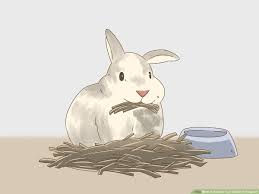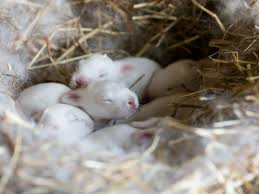A guide to rabbit pregnancy
- Jessica O'dwyer
- Aug 1, 2022
- 5 min read
Updated: Sep 11, 2022

Rabbit pregnancy signs
You can tell if your rabbit is pregnant in several ways:
Nest building – does instinctively build a nest using hay or straw when they are pregnant
Fur pulling – soon-to-be mothers pull their own fur out to use as a blanket to keep the babies warm
Aggressive behavior – your rabbit may growl defensively or refuse to be petted or stroked
Increased Appetite - Your rabbit will want to do less but will eat and drink twice as much to give her babies the right nutrition
Getting Bigger - One of the most obvious signs of pregnancy in all animals is prominent weight gain. You’ll notice through the weeks, that your bunny will get wider and wider, however, it is sometimes not noticeable.
Developing Nipples - The most obvious sign that your rabbit is expecting is when she develops nipples. As your rabbit reaches the final weeks of her pregnancy, she’ll start developing breasts and milk to feed her babies.
Preparing for the new arrivals
During pregnancy, the mother rabbit will need lots of clean water and nutritious food, including dark leafy greens, alfalfa hay, and rabbit pellets.
Rabbits sometimes dig a burrow in which to give birth – if you want to avoid this happening, make sure that your rabbit has a proper nest box and plenty of privacy to make sure she is as relaxed as possible.

Rabbit Pregnancy Timeline (Week by Week)
Rabbit gestation can last up to 34 days, which is just short of 5 weeks. Here’s what you can expect during a rabbit pregnancy from week to week.
Week 1-During the first week, you might not see any signs at all. Your rabbit may start to eat a bit more. But you’re not likely to see much until at least the 10th day.
Week 2-Midway through week two, you will be able to feel small bumps, which are the fetuses. The male should be kept away from this point, as she will become aggressive towards him, and a fight could cause an accidental miscarriage.
Week 3-Your rabbit’s babies are now developing in her womb. So, from the third week on, it’s best to refrain from touching or picking up your pregnant rabbit. She’ll be much bigger and may start to make preparations.
Week 4-5-Through the 4th week (and maybe a few days afterward), your rabbit is now in full prep mode. She’ll be much more maternal and will start creating a nest for her clutch.

Rabbit labor
A rabbit’s gestation period is typically between 31 and 34 days. It is recommended to put in a nest box at 28 days as nest building usually occurs within the last few days of pregnancy. When a doe gives birth, it is called kindling. Kindling takes around 15 minutes and usually occurs in the early hours of the morning. The process of giving birth is instinctive and obstruction is virtually unheard of.
After checking on the babies, try to leave the nest alone for the first few days – disturbing a mother rabbit can cause her distress, and she may stop feeding her young. This is a common perception however you will need to check young daily as they use each other to keep warm if one dies then the rest will get cold.
Be very careful when reaching into your rabbit’s enclosure after she’s given birth. Your rabbit will likely become protective and territorial. She may try to attack you, thinking you’re taking her babies away. So, limit your contact to feeding and just looking in on them. You will also find that your doe bleeds if it has not cleared up or stopped by 1-2 weeks see your vet.
Rabbit litters
Baby rabbits are called kits, and there can be up to 14 kits in a litter, with seven being the average number. The larger breeds will often give birth to more than a smaller breed. They are born hairless, blind, and deaf, but, after 10 days, they will begin to develop features.
The doe will nurse her kits twice a day at dawn and dusk, which only takes around five minutes due to the rich quality of the mother’s milk. Kits are usually fully weaned when they are between four to six weeks old. You should keep a female rabbit separate from males during this time, as female rabbits can be re-impregnated hours after giving birth.
Space for the doe
It is a good idea to provide an area in the doe’s enclosure for her to get away from the kits. Unlike cats or dogs, does instinctively don’t want to be near their kits. This is because they don’t want to draw the attention of predators to the existence of kits in the nest.
So create a comfortable area for the doe that is away from the kits, but is constantly available to her and gives her the choice to go back to the kits whenever she wants.

Checking the Babies
You should be poking your head daily to check if the babies are doing okay. Check if all of their bellies are full. If they are, they’re being fed well and there’s nothing to worry about.
However, if they look sunken in and wrinkled, this may mean that your rabbit isn’t able to feed them. Should this be the case, both mom and the babies will require vet assistance ASAP.
Cookies' first litter didn't survive and on day three one by one they died due to not being fed well, most first-time young moms may not have produced milk and may need a shot from the vet to help them feed their babies.
Newborn - eyes and ears are shut, no fur, and dependent on mother for food and stimulating poo and pee
Five to ten days old - eyes and ears are open or opening and the baby can fit in the palm of your hand, the fur starts to grow, still dependent on the mother for food and stimulating poo and pee.
Two to three weeks old - Still relying on smell to move, ready for alfalfa hay, can move around inside the nest, can eat mother's cecotropes left in the nest, and can pee/poo without stimulation.
Four to Seven weeks old - bigger, softer, thicker fur, can move out of the nest and run, jump. Weaning would be started and completed by seven weeks so that babies are on hay, pellets, and fresh grass.
Eight weeks - Ready to be rehomed, no longer dependent on mother or siblings, able to tell the sex of the bunnies.
Rehoming the infants
The kits can leave their mother at around eight weeks after their birth, at which stage you can look at rehoming them.
When looking for their new homes, check that potential owners have clean, spacious accommodations and that a responsible adult will be on hand to feed them a healthy diet and be able to cover any medical costs, including vaccinations and neutering.
False rabbit pregnancies
Occasionally, rabbits experience a false pregnancy. In cases like this, the doe may exhibit typical rabbit pregnancy behaviors, such as nest building. The best way to know for sure whether your doe is pregnant is to take her to a vet.
Desexing
Many unwanted rabbits end up at rescue centers. So it is important to consider getting your rabbits neutered. Desexing will make it possible for you to keep a male/female pair together while avoiding rabbit pregnancy. It is usually cheaper to desex a male rabbit, due to the bits being removed on the outside, in females, the desexing is harder and they have to get inside to remove the bits.


Comments